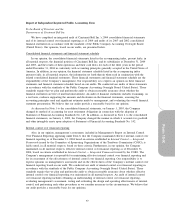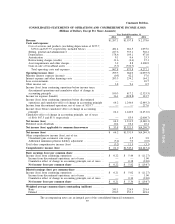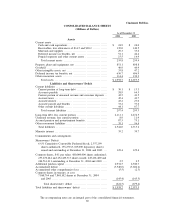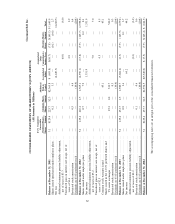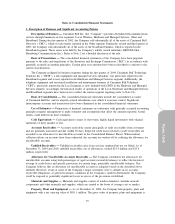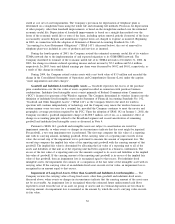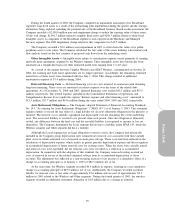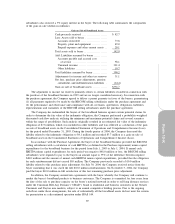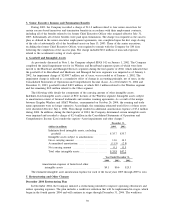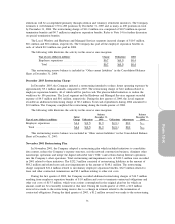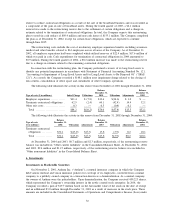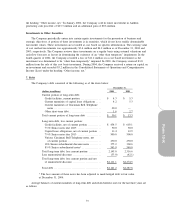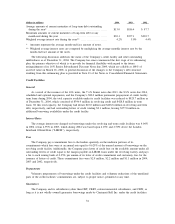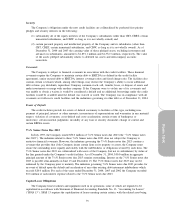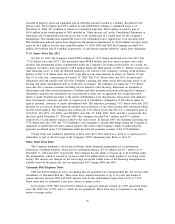Cincinnati Bell 2004 Annual Report Download - page 140
Download and view the complete annual report
Please find page 140 of the 2004 Cincinnati Bell annual report below. You can navigate through the pages in the report by either clicking on the pages listed below, or by using the keyword search tool below to find specific information within the annual report.
The adoption of SFAS 143 had an immaterial pro forma impact on net income for the year ended
December 31, 2002. The following table illustrates the activity for the asset retirement obligation during 2004:
(dollars in millions)
Initial
Liability Additions
Accreted
Interest Adjustments
Balance
December 31,
2003 Additions Settlements
Accreted
Interest Adjustments
Balance
December 31,
2004
Wireless ........... $1.8 $ — $0.2 $1.9 $3.9 $0.5 $ — $0.2 $0.3 $4.9
Other ............. 0.8 0.1 — — 0.9 0.1 (0.4) — — 0.6
Total ............ $2.6 $0.1 $0.2 $1.9 $4.8 $0.6 $(0.4) $0.2 $0.3 $5.5
Investments — The Company invests in certain equity investments, which do not have readily
determinable fair market values. These investments are recorded at cost based on specific identification.
Investments are periodically reviewed for impairment. If the carrying value of the investment exceeds its fair
value and the decline in value is determined to be other-than-temporary, an impairment loss would be
recognized for the difference.
Revenue Recognition — The Company recognizes revenue as services are provided. Local access fees
are billed monthly, in advance, while revenue is recognized as the services are provided. Postpaid wireless,
long distance, switched access, reciprocal compensation and data and Internet product services are billed
monthly in arrears, while the revenue is recognized as the services are provided. The Company bills service
revenue in regular monthly cycles, which are dispersed throughout the days of the month. Because the day of
each billing cycle rarely coincides with the end of the Company’s reporting period for usage-based services
such as postpaid wireless, long distance and switched access, the Company must estimate service revenues
earned but not yet billed. The Company bases its estimates upon historical usage and adjusts these estimates
during the period in which the Company can determine actual usage, typically in the following reporting
period. These adjustments may have a material impact upon operating results of the Company during the
period of the adjustment.
CBT upfront fees for customer connection and activation are deferred and amortized into revenue on a
straight-line basis over the average customer life. The related connection and activation costs, to the extent of
the upfront fees, are deferred and amortized on a straight-line basis over the average customer life. Subsequent
to July 1, 2003 and in accordance with the Emerging Issues Task Force Issue 00-21, “Accounting for Revenue
Arrangements with Multiple Deliverables” (“EITF 00-21”), Cincinnati Bell Wireless LLC (“CBW”) ceased
deferral of revenue and cost related to customer connections and activations. As CBW does not require
customer contracts and sells its services at fair market value, the activation revenue is allocated to and
recorded upon the sale of the wireless handset. This change did not have a material impact on the Company’s
financial position, results of operations, or cash flows.
The Company recognizes equipment revenue generally upon the performance of contractual obligations,
such as shipment, delivery, installation or customer acceptance.
Prior to the sale of the broadband assets in the second and third quarters of 2003, broadband transport
services were billed monthly, in advance, while revenue was recognized as the services were provided. In
addition, the Company had entered into indefeasible right-of-use (“IRU”) agreements, which represent the
lease of network capacity or dark fiber, recording unearned revenue at the earlier of the acceptance of the
applicable portion of the network by the customer or the receipt of cash. The buyer of IRU services typically
paid cash or other consideration upon execution of the contract, and the associated IRU revenue was
recognized over the life of the agreement as services were provided, beginning on the date of customer
acceptance. In the event the buyer of an IRU terminated a contract prior to the contract expiration and
released the Company from the obligation to provide future services, the remaining unamortized unearned
revenue was recognized in the period in which the contract was terminated. The Company generated $59.4
million and $204.8 million in non-cash IRU revenue in 2003 and 2002, respectively. Concurrent with the
broadband asset sale, substantially all of the remaining IRU obligations were assumed by the buyer of the
broadband assets.
Pricing of local services is generally subject to oversight by both state and federal regulatory
commissions. Such regulation also covers services, competition and other public policy issues. Various
66



